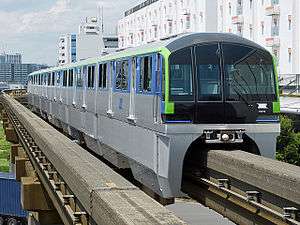Tokyo Monorail 10000 series
| Tokyo Monorail 10000 series | |
|---|---|
|
Set 10011 in July 2014 | |
| In service | July 2014 – |
| Replaced | 1000 series |
| Constructed | 2014– |
| Number built | 24 vehicles (4 sets) |
| Number in service | 24 vehicles (4 sets) |
| Formation | 6 cars per trainset |
| Fleet numbers | 10011–10041 |
| Operator(s) | Tokyo Monorail |
| Depot(s) | Showajima |
| Line(s) served | Tokyo Monorail Haneda Airport Line |
| Specifications | |
| Car body construction | Aluminium alloy |
| Car length |
16,400 mm (53 ft 10 in) (end cars) 15,200 mm (49 ft 10 in) (intermediate cars) |
| Width | 3,038 mm (9 ft 11.6 in) |
| Height | 4,364 mm (14 ft 3.8 in) |
| Doors | 2 pairs per side |
| Maximum speed | 80 km/h (50 mph) |
| Traction system | IGBT-VVVF |
| Acceleration | 3.5 km/h/s |
| Deceleration |
4.0 km/h/s (service) 4.5 km/h/s (emergency) |
| Electric system(s) | 750 V DC |
| Current collection method | Side contact |
| Safety system(s) | ATC |
| Track gauge | (straddle-beam monorail) |
The Tokyo Monorail 10000 series (東京モノレール10000形 Tōkyō Monorēru 10000-gata) is a monorail electric multiple unit (EMU) train type operated by the Tokyo Monorail on the Tokyo Monorail Haneda Airport Line in Japan since July 2014.[1]
Design
The body design is based on the earlier 2000 series trains first built in 1997, and uses friction stir welded (FSW) aluminium alloy panels.[2]
 The interior of the driving cab
The interior of the driving cab
Formation
As of 1 April 2016, the fleet consists of four six-car sets, numbered 10011 to 10041, and formed as shown below, with four motored ("M") cars and two non-powered trailer ("T") cars.[1] Car 1 is at the Hamamatsucho end.[1][3]
| Car No. | 1 | 2 | 3 | 4 | 5 | 6 |
|---|---|---|---|---|---|---|
| Designation | Tc1 | M1 | M2 | M3 | M4 | Tc2 |
| Numbering | 100x1 | 100x2 | 100x3 | 100x4 | 100x5 | 100x6 |
| Weight (t) | 23.3 | 23.7 | 24.1 | 23.8 | 24.0 | 23.0 |
| Capacity (seated/total) | 33/76 | 40/76 | 40/76 | 40/76 | 40/76 | 33/76 |
- "x" stands for the set number.
- Cars 1 and 6 each have a wheelchair space.[3]
Interior
Passenger accommodation consists of a mixture of facing 4-seat bays and longitudinal bench seating, and includes luggage racks next to the doorways.[2] The seats are covered in a blue moquette incorporating the traditional Japanese seigaiha (青海波) pattern.[2] LED lighting is used throughout.[2] Passenger information is provided by 7-inch wide LCD displays above the doorways.[2] Information is provided in four languages: Japanese, English, Chinese, and Korean. Initially one screen is provided above each doorway, but provision is made for installing a second screen in the future.[2]
 Longitudinal seating
Longitudinal seating Facing 4-seat bays
Facing 4-seat bays Seating over the train bogies
Seating over the train bogies
History
The first set, 10011, was delivered to Tokyo Monorail's Showajima Depot in March 2014.[4] It entered revenue service on 18 July 2014.[5]
- The first set delivered, 10011, at Showajima Depot in March 2014
References
- 1 2 3 "東京モノレール10000形" [Tokyo Monorail 10000 series]. Japan Railfan Magazine. Vol. 54 no. 638. Japan: Koyusha Co., Ltd. June 2014. pp. 80–81.
- 1 2 3 4 5 6 Harada, Junichi (April 2014). 新型車両10000形の導入について [Introduction of new 10000 series rolling stock]. Tetsudō Daiya Jōhō Magazine (in Japanese). Vol. 43 no. 360. Japan: Kotsu Shimbun. pp. 32–34.
- 1 2 私鉄車両編成表 2016 [Private Railway Rolling Stock Formations - 2016] (in Japanese). Japan: Kotsu Shimbunsha. 25 July 2016. p. 80. ISBN 978-4-330-70116-5.
- ↑ 東京モノレール10000形が昭和島車両基地に搬入される [Tokyo Monorail 10000 series delivered to Showajima Depot]. Japan Railfan Magazine Online (in Japanese). Japan: Koyusha Co., Ltd. 5 March 2014. Retrieved 19 March 2014.
- ↑ 指原莉乃が出発進行!東京モノレールに新型車両、「和」デザイン [New Tokyo Monorail train with "Wa" design seen off by Rino Sashihara]. Sponichi Annex (in Japanese). Japan: Sports Nippon Newspapers. 18 July 2014. Retrieved 18 July 2014.
External links
| Wikimedia Commons has media related to Tokyo Monorail 10000 series. |
- September 2013 press release (in Japanese)
